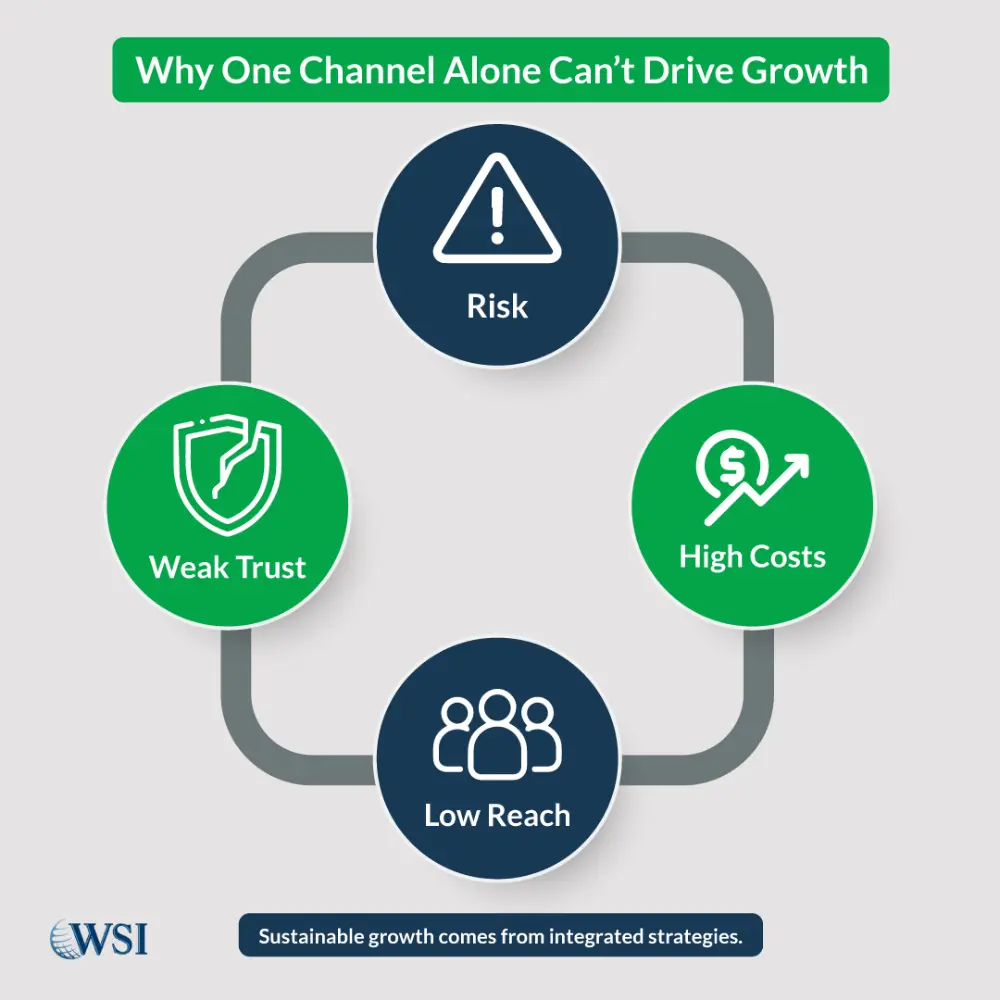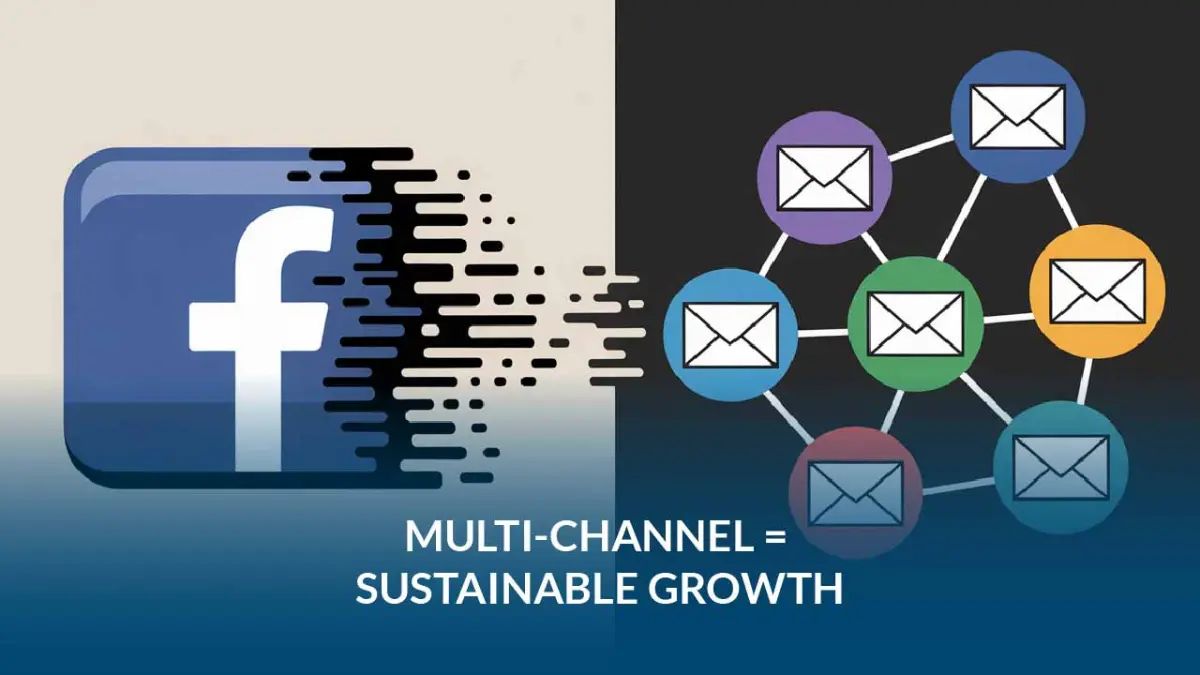Relying on a single marketing tactic may deliver quick wins, but it can’t sustain growth. Buyers today expect a consistent experience across channels. They don’t discover, research, and convert in one straight line. Instead, they bounce between search engines, social media, reviews, emails, and websites before making a decision. If you only show up in one place, you lose visibility, credibility, and control over your pipeline.
Key Takeaways
- Overdependence on one marketing channel creates risk, raises acquisition costs, and limits brand visibility.
- A connected mix of SEO, content, paid media, social, and user experience builds trust and drives conversions.
- Data and analytics allow you to unify campaigns, eliminate wasted spend, and scale growth predictably.
Contents
Why Single-Channel Marketing Breaks Down
It might seem efficient to pour budget into one channel, say Google Ads or Instagram campaigns, but every platform is volatile. Algorithms change, costs climb, and user behaviour shifts. When that happens, businesses relying on just one tactic watch leads dry up overnight.
Take Facebook Ads as an example. Many e-commerce companies grew rapidly on the platform until CPMs doubled and targeting rules tightened. Those without other traffic sources saw costs soar and conversions collapse. In B2B, firms that depended solely on organic search often hit the same wall, when Google released a core update, rankings shifted and inquiries plummeted.
An integrated mix spreads risk. If SEO rankings slip, paid campaigns can steady lead flow. If ad costs spike, organic and referral channels reduce reliance on bidding wars. This balance ensures your brand stays visible regardless of platform changes.
How Customers Really Make Decisions

Google reports that 95% of buyers use multiple channels before making a purchase. In B2B, nearly nine out of ten executives expect companies to engage across search, social, and email. Even in healthcare, patients check websites, reviews, and local listings before booking an appointment.
This means one channel alone can’t cover the entire path to conversion. Imagine a prospect searching for “IT consulting,” finding your website, but then failing to see reviews or social proof. Trust gaps make them second-guess you. Or picture a clinic running paid ads but not appearing in local search results; patients are unlikely to book because they can’t validate credibility.
Multichannel behaviour has intensified since 2020 as digital adoption surged. Buyers want reassurance, proof, and multiple interactions before they commit. Ignoring this zig-zag path leaves revenue on the table.
Building Trust Through Integration
Visibility alone won’t win new business. People may find you through search, ads, or social, but they won’t move forward unless they trust you. In crowded markets, credibility is what separates a curious click from a qualified lead. That trust is rarely built in one place; it comes from repeated, consistent signals across every channel. When your paid ads, organic search results, content, reviews, and website experience all reinforce each other, you create a brand presence that feels reliable, established, and worth engaging with.
Search Engines and Ads Work Best Together
Brands that appear in both paid ads and organic listings capture more clicks than those relying on one or the other. Studies show dual presence lifts credibility, since prospects see you multiple times on the same page. One university that combined SEO with paid campaigns saw a 138% increase in conversions and a 159% lift in organic traffic.
Content Creates Authority
Articles, guides, videos, and case studies build confidence before a sales call ever happens. According to Conductor, customers who consume educational content are 131% more likely to purchase from that brand. In education and healthcare, content like program guides or patient FAQs positions you as the knowledgeable choice.
Social Proof Reinforces Credibility
Engaged profiles, reviews, and testimonials serve as validation. In healthcare, 90% of patients check reviews before booking. In B2B, prospects look for case studies and conversations on LinkedIn before responding to outreach. Social reinforces what SEO and content started.
Local SEO Connects You With High-Intent Buyers
Local service businesses rely heavily on being visible in “near me” searches. Clinics that optimise Google Business Profiles and gather reviews outperform those that ignore local SEO. Without this visibility, you effectively don’t exist to nearby buyers.
Website UX Closes the Loop
All traffic eventually lands on your website. If it loads slowly, looks dated, or lacks trust signals, conversions fall flat. Studies show first impressions are 94% design-driven, and up to 75% of users judge credibility based on design quality. A fast, mobile-friendly, professional site with testimonials and clear CTAs keeps leads moving forward.
Lowering Costs With Channel Synergy
One of the strongest benefits of integration is cost efficiency. Channels working together reduce waste and improve ROI.
- SEO + PPC: SEO insights reveal which keywords drive conversions, guiding smarter ad spend. At the same time, strong landing pages built for SEO boost ad Quality Scores, lowering cost per click.
- Content + Ads: Dedicated landing pages aligned with campaigns improve conversion rates. Without them, 44% of ad clicks are wasted by sending visitors to generic homepages.
- Retargeting: Serving tailored ads to past visitors is cheaper and more effective than reaching cold audiences. These campaigns convert more because familiarity is already established.
- Cross-Team Alignment: Disconnected teams often duplicate efforts, targeting the same prospects with inconsistent messages. Coordinated campaigns prevent overlap, delivering up to 300% higher conversion rates compared to siloed efforts.
When channels share insights, you avoid paying twice for the same lead, and every dollar goes further.
Case Studies: Integration in Action
Healthcare Clinic
A clinic ran only Google Ads and saw clicks but few bookings. After adding local SEO, educational blogs, reviews, and retargeting ads, patient calls and online appointments grew. Cost per acquisition dropped since many patients found them organically.
B2B Consulting Firm
This firm bid on broad paid search terms and faced rising costs. They integrated SEO with niche content, aligned landing pages with ad promises, and added LinkedIn campaigns. Leads became more qualified, ad spend decreased, and conversions increased.
Continuing Education Provider
Once reliant on email blasts, they built a connected strategy: SEO blogs on career outcomes, social media showcasing alumni success, paid ads targeting specific program keywords, and nurture emails. Applications rose steadily, and cost per enrolment fell thanks to the reinforcing effect of multiple touchpoints.

See how integration fuels real growth
Case studies prove that combining channels lifts conversions and lowers costs.
Creating Your Integrated Digital Marketing Mix
An effective mix typically includes:
- SEO for visibility and credibility
- Content marketing for education and trust
- Paid media for instant reach and targeting
- Social media for proof and community building
- Website UX and trust factors for conversion readiness
- Email and CRM nurturing for lead retention and repeat business
- Analytics and attribution to measure how each channel assists the others
Think of this as an ecosystem. If one element is missing, the system weakens. PPC without content wastes money. SEO without trust signals fails to convert. Analytics without integration misreads where growth really comes from. Each piece multiplies the others when aligned.
From Fragile Growth to Resilient Systems
Single-channel tactics may offer short bursts of traffic, but they rarely support sustainable growth. Integrated strategies not only diversify risk but also make each touchpoint stronger. SEO attracts demand, content educates, social validates, paid ads amplify, and your website converts. Analytics ties everything together so you can refine continuously.
For leaders in B2B, healthcare, and education, the message is clear: don’t gamble on one channel. Build a system that reflects how buyers really decide. It’s the difference between unpredictable spikes and steady, scalable revenue.

Ready to future-proof your growth?
We’ll design a multi-channel strategy that lowers cost per lead and drives steady, qualified demand.


